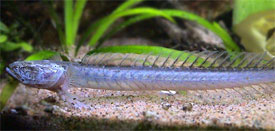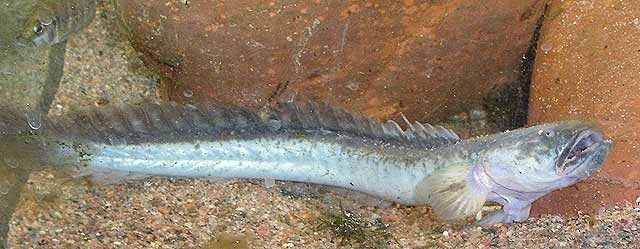
Gobioides broussoneti
FAMILY
Gobiidae
TAXONOMY
Gobioides broussonnetii Lacepede, 1800, Suriname.
OTHER COMMON NAMES
German: Lila Aalgrundel; Spanish: Lamprea; Portuguese:
Aimore.
PHYSICAL CHARACTERISTICS
To about 21.6 in (55 cm) total length. The body is elongate
and eel-like. Dorsal fins united to form a long continuous fin
confluent with the caudal fin. Anal fin also connected to caudal
fin. The caudal fin is long and pointed. Pelvic fins are united
to form a concave disk. The mouth is large and oblique. The
eyes are small and high on the head. The body and head are
purple brown, the abdomen and underside of the head are
white. A series of dark chevrons, angled forward, extends along
the sides.
DISTRIBUTION
Western Atlantic, Gulf and Caribbean coasts of the Americas,
extending from Brunswick County, North Carolina, to Rio
Grande do Sul, Brazil. Also on coasts of Cuba, Hispaniola, and
Puerto Rico in the Caribbean.
HABITAT
Lives on muddy bottoms and in burrows; inhabits tidal freshwater
and low salinity estuaries offshore from large rivers; one
individual was found 298.5 ft (91 m) off the Mississippi River
in Louisiana.
BEHAVIOR
No published information is available, but some is forthcoming
from the aquarium trade. Males display for females before
spawning by raising and lowering the dorsal fin, and swimming
in and around the potential nest site. Males become territorial
after spawning and guard the nest.
FEEDING ECOLOGY AND DIET
The long coiled gut suggests that it feeds on diatoms, algae,
and tiny invertebrates sifted from sediments.
REPRODUCTIVE BIOLOGY
In the aquarium, spawning may last 12–24 hours. Eggs are deposited
in nests under an object, presumably within a burrow
in the wild. Eggs hatch in 36–38 hours. Males usually guard
the fry until they swim freely.
CONSERVATION STATUS
Not threatened.
SIGNIFICANCE TO HUMANS
No commercial fishing values, but becoming an increasing part
of the aquarium trade because of its interesting appearance.
Other popular Animals
Photo Gallery of - Violet goby





 Animalia Life
Animalia Life